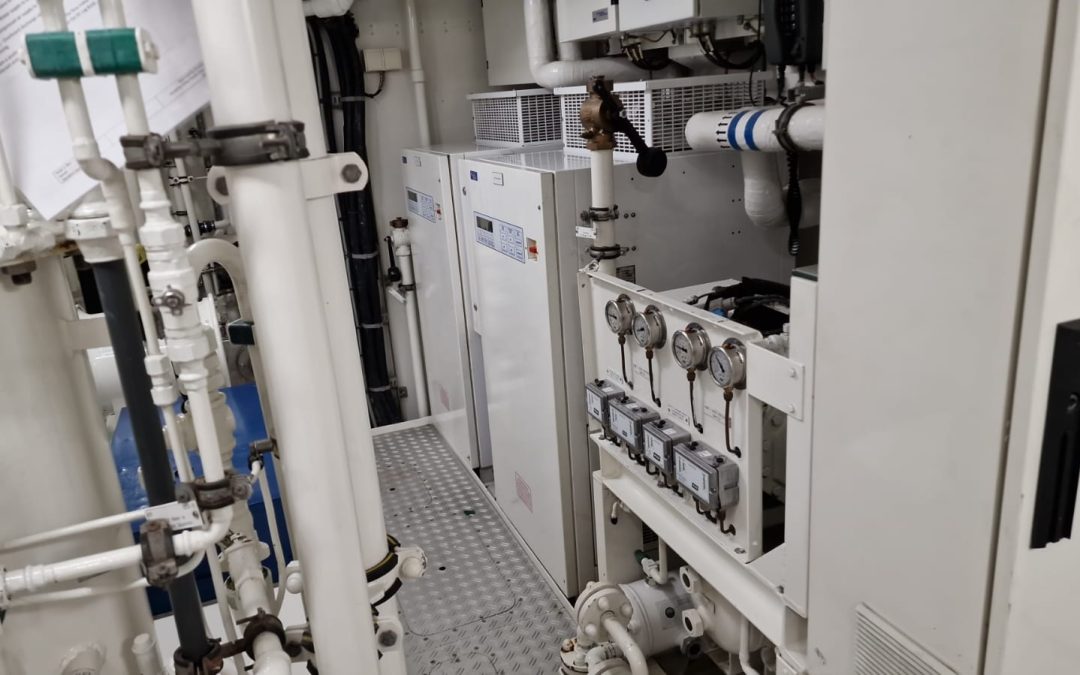During a recent inspection aboard a yacht equipped with an ASEA Shore Power Converter running in parallel with a generator, an unexpected issue emerged. While the system appeared to be operating normally, a sudden power transfer between shore supply and generator triggered a complete power loss. The Residual Current Device (RCD) tripped, cutting power to the entire vessel.
Though seemingly routine, this incident highlighted a deeper issue. Upon investigation, we detected a DC leakage current of 200mA, significantly above the 30mA trip threshold typical of most RCDs. This was not a minor anomaly but a symptom of a serious fault in the grounding system.
As we delved deeper into the root cause, a critical flaw in the grounding configuration was revealed. A ground was tied to neutral at two separate locations once at the converter’s terminal block and again at the generator. This dual bonding had created an unintended grounding loop, allowing stray currents to circulate through the system instead of following their intended path.
What exactly is a grounding loop?
A grounding loop occurs when multiple ground connections exist at different points in an electrical system. This configuration forms an unintentional circuit, enabling stray current to flow between those ground points. In marine systems, such loops often arise from improper or duplicated bonding.
A common example involves both the shore power converter and the generator having individual neutral-to-ground connections, even though they share a common grounding conductor. This arrangement forms a loop, allowing current to circulate in unpredictable ways, often triggering protective devices like RCDs.
ABYC guidelines recommend connecting the shore-side grounding conductor directly to the transformer casing without interruptions. On your boat’s side, the transformer should have its own dedicated grounding point linked clearly to your vessel’s bonding system. Getting this right is important to avoid hazardous ground loops that could raise the risk of ESD. Specifically, ABYC E-11 recommends having just one clear bonding point, usually connected to your boat’s main DC negative bus or engine block.


In more complex installations, grounding loops may also result from the internal design of shore power converters. Many converters include separate grounding terminals: one connected to the chassis and another to the converter’s internal electronics. While each serves a purpose, improper integration into the vessel’s bonding system can introduce internal grounding paths. If not carefully consolidated to a single point, these paths can result in circulating current through the vessel’s metal hull.
In such cases, the RCD although functioning correctly, interprets this imbalance as a fault. Once the stray current exceeds its trip threshold, the RCD disconnects the power to prevent potential harm. This means that even without a direct ground fault, the system may shut down unexpectedly. These problems are especially prominent on larger vessels with steel hulls, where seamless power transfers may frequently take place. Such operations are more likely to reveal grounding flaws, making large yachts particularly vulnerable to grounding loop issues.
How RCDs Respond to Leakage
RCDs are designed to monitor the current balance between phase and neutral conductors. Under normal operation, the current entering and exiting the system remains equal, canceling out within the sensing coil. If current leakage occurs, whether due to insulation damage, equipment faults, or grounding loops, the imbalance generates a magnetic field that activates the trip mechanism. Power is cut off immediately to protect both personnel and equipment.

Improper bonding and grounding practices can lead to repeated, unexplained power disruptions, issues that are not only inconvenient but may compromise system reliability. This case underscores the importance of thorough system inspections, especially when multiple power sources are involved. Ensuring that grounding and bonding are correctly configured, and that RCDs are properly installed and calibrated, can prevent unnecessary shutdowns and provide a more stable power environment on board.
Grounding loops remain one of the most frequently overlooked causes of RCD nuisance trips in marine systems. Addressing them requires attention to detail, collaboration between system designers and installers, and a clear understanding of how marine power systems operate under real-world conditions.

